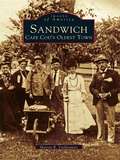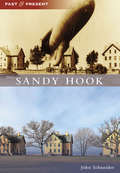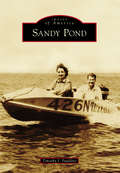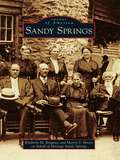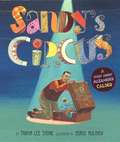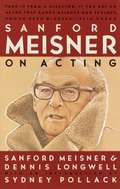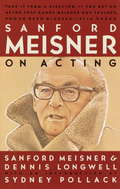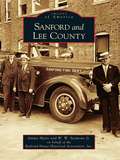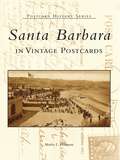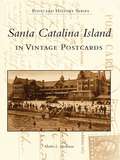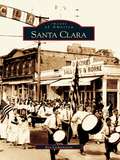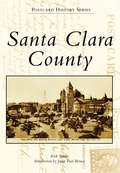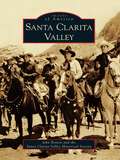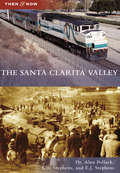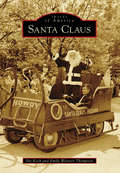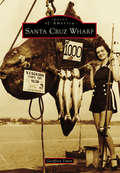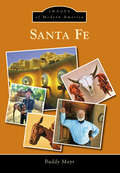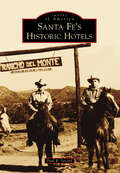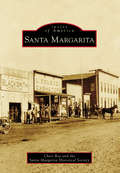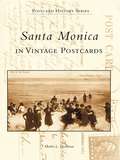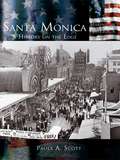- Table View
- List View
Sandwich: Cape Cod's Oldest Town
by Marion R. VuilleumierKnown as the place where glassblowers produced masterpieces for international markets in the 1800s and where some of New England's oldest homes still stand, Sandwich is a vibrant community rich in history. Founded in 1637, this gateway town to Cape Cod is actually a time capsule of the last four centuries, from prehistory, when it was the territory of the Native American Wampanoags, to the tourist destination and bedroom community of Boston and Providence it is today. In Sandwich: Cape Cod's Oldest Town, the reader will be taken on a historical journey to enchanting places, such as the Sandwich Glass Museum, featuring masterpieces from the Boston & Sandwich Glass Company of the mid-1800s, and Heritage Plantation's seventy-six acres of landscaped gardens and antique displays, including a working 1912 carousel. Visit the Green Briar Nature Center, which produces jam made by the sun; a museum featuring native son Thornton W. Burgess's "Briar Patch" children's stories; the venerable, classic saltbox-type Hoxie House, where life in those earliest years is re-created; and the Wing and Nye homesteads, which in summer represent several centuries of Sandwich culture and history.
Sandwiches Without Bread: 100 Low-Carb, Gluten-Free Options!
by Daria PolukarovaLet these enticing photos and simple instructions persuade you to better your daily eating habits. Healthy, filling, and delicious, they are budget-friendly and adjustable to any diet. Whether you follow a Paleo, non-gluten, low-carbohydrate, or just an all-around healthy lifestyle, Sandwiches Without Bread is for you. Featuring one hundred creative recipes along with mouthwatering photographs, this book will appeal to both your appetite and your waistline. Instead of bread, sandwiches can be made as lettuce wraps, between scooped cucumber, apple slices, grilled eggplant or pineapple, and dozens of other substitutes?the options are endless. Recipes include: Smoked tofu banh mi Crispy one-bite cracker sandwiches Easy nori sandwich with butterfish Crab cucumber roll-ups Zucchini panini Pesto chicken halloumi sandwich Lentil pancake sandwich with herbed mushrooms Cauliflower breakfast cups So many more!
Sandy Hook (Past and Present)
by John SchneiderSandy Hook, New Jersey, as well as its historical significance to world events, oddly remains a mystery to many of the tourists who come to its beaches and explore its ruins. The oldest structure, the Sandy Hook Lighthouse, was erected in 1764. Today, thousands of people climb the steps of this national historic landmark to reach the highest point on the peninsula. Many others roam through some of the open buildings and ruins of Fort Hancock and the Sandy Hook Proving Ground where soldiers were once ready to defend New York City from enemy attack and tested weapons of war.
Sandy Pond (Images of America)
by Timothy J. PauldineNatural beauty, abundant game, and a sandy lakeside location: these are the reasons people have come to Sandy Pond for hundreds of years. Sandy Pond's fascinating history includes Native Americans, early entrepreneurs, bootleggers, and even a vice president of the United States. Formed by retreating glaciers that carved the landscape, Sandy Pond is located on the eastern shore of Lake Ontario. More a lake than a pond, it is protected from Lake Ontario's wind and waves by a barrier dune system and a sandy beach, with an outlet to that Great Lake. This has made Sandy Pond a safe harbor for vessels during dangerous weather. As far back as 1675, when he marched against the Iroquois, Samuel de Champlain wrote of traveling "over a sandy plain" where he found "a very pleasing and fine country, a number of ponds and prairies, where there was an infinite quantity of game, a great many vines and fine trees." Sandy Pond's natural and man-made treasures continue to make it a year-round destination for nature enthusiasts.
Sandy Springs
by Kimberly M. Brigance Morris V. Moore Heritage Sandy SpringsSandy Springs has always been a community in transition. Bounded to the north by the Chattahoochee River, the area was contested by both the Cherokee Nation and the Creek Confederacy, who used the river as a territorial marker. To the south, the urban center of Atlanta has blessed and, at times, cursed her rural neighbor with close proximity. Today Sandy Springs is still in transition. From a rural village to one of Georgia's newest cities, the history of Sandy Springs is a story of change.
Sandy's Circus: A Story About Alexander Calder
by Tanya Lee Stone Boris KulikovAs a boy, Alexander ?Sandy? Calder was always fiddling with odds and ends, making objects for friends. When he got older and became an artist, his fiddling led him to create wire sculptures. One day, Sandy made a lion. Next came a lion cage. Before he knew it, he had an entire circus and was traveling between Paris and New York performing a brand-new kind of art for amazed audiences. This is the story of Sandy?s Circus, as told by Tanya Lee Stone with Boris Kulikov?s spectacular and innovative illustrations. Calder?s original circus is on permanent display at the Whitney Museum in New York City.
Sanford Meisner on Acting
by Sanford Meisner Dennis LongwellThis book, written in collaboration with Dennis Longwell, follows an acting class of eight men and eight women for fifteen months, beginning with the most rudimentary exercises and ending with affecting and polished scenes from contemporary American plays. Throughout these pages Meisner is delight--always empathizing with his students and urging them onward, provoking emotion, laughter, and growing technical mastery from his charges. With an introduction by Sydney Pollack, director of "Out of Africa" and "Tootsie," who worked with Meisner for five years. "This book should be read by anyone who wants to act or even appreciate what acting involves. Like Meisner's way of teaching, it is the straight goods."--Arthur Miller. "If there is a key to good acting, this one is it, above all others. Actors, young and not so young, will find inspiration and excitement in this book."--Gregory Peck
Sanford Meisner on Acting
by Sanford Meisner Dennis Longwell Sydney PollackThis book, written in collaboration with Dennis Longwell, follows an acting class of eight men and eight women for fifteen months, beginning with the most rudimentary exercises and ending with affecting and polished scenes from contemporary American plays. Throughout these pages Meisner is delight--always empathizing with his students and urging them onward, provoking emotion, laughter, and growing technical mastery from his charges. With an introduction by Sydney Pollack, director of "Out of Africa" and "Tootsie," who worked with Meisner for five years."This book should be read by anyone who wants to act or even appreciate what acting involves. Like Meisner's way of teaching, it is the straight goods."--Arthur Miller"If there is a key to good acting, this one is it, above all others. Actors, young and not so young, will find inspiration and excitement in this book."--Gregory Peck
Sanford and Lee County (Images of America)
by Jimmy Haire Railroad House Historical Association, Inc. W. W. Seymour Jr.Located near the geographic center of North Carolina, the Lee County area has been defined by transportation for the past two centuries. From river navigation along the Deep and Cape Fear Rivers to early plank roads, crisscrossing railroad lines, and major U.S. highways, this area has seen countless travelers come and go by boat, car, horse, buggy, train, and motor vehicle. Along the way, a number of the travelers settled, and communities formed. Through the efforts of leaders from communities such as Jonesboro and Sanford, a new county was formed in 1907-1908. Lee County was the 98th county formed in North Carolina, and despite its relatively small land area, it has a rich and vital history.
Sanitation Details
by L. WoolleyA companion volume to Drainage Details, the two volumes provide a compact and exact source of reference dealing with the drainage of buildings from sanitary appliance through the underground drainage network, to the final outfall.
Sanja Ivekovi: Triangle
by Ruth NoackIn Sanja Ivekovi's Triangle ( Trokut, 1979),four black-and-white photographs and written text capture an eighteen-minute performance from May10, 1979. On that date, a motorcade carrying Josip Broz Tito, then president of Yugoslavia, drovethrough the streets of downtown Zagreb. As the President's limousine passed beneath her apartment,Ivokevic began simulating masturbation on her balcony. Although she could not be seen from thestreet, she knew that the surveillance teams on the roofs of neighboring buildings would detect herpresence. Within minutes, a policeman appeared at her door ordered her inside. Not only didIvekovic's action expose government repression and call attention to the rights of women, it alsocalled attention to the relationship of gender to power, and to the particular experience ofpolitical dissidence under communist rule in Eastern Europe. Triangle isconsidered one of Ivekovi's key works and yet, despite Ivekovi's stature as one of the leadingartists of the former Yugoslavia, it has received little direct attention. With this book, RuthNoack offers the first sustained examination of Ivekovi's widely exhibited, now canonicalartwork. After a detailed analysis of the work's formal qualities, Noack considersits position in the context of artistic production and political history in socialist Yugoslavia. She looks closely at the genesis of the performance and its documentation as a work of art, andrelates the making of the work and the politics of canon-making to issues pertaining to the formerEast-West divide. She discusses the artistic language and meaning-making in relation toconceptualism and performance and to the position of women in Tito's Yugoslavia and in society atlarge, and investigates the notion that Ivekovi's work of this period is participating incitizenship, shifting the focus from the artist's subversive act to her capacity to shape the termsthrough which we order our world.
Sanja Iveković: Triangle (One Work)
by Ruth NoackThe first sustained examination of a canonical and widely exhibited work by a leading artist of the former Yugoslavia. In Sanja Iveković's Triangle (Trokut, 1979), four black-and-white photographs and written text capture an eighteen-minute performance from May 10, 1979. On that date, a motorcade carrying Josip Broz Tito, then president of Yugoslavia, drove through the streets of downtown Zagreb. As the President's limousine passed beneath her apartment, Ivokevic began simulating masturbation on her balcony. Although she could not be seen from the street, she knew that the surveillance teams on the roofs of neighboring buildings would detect her presence. Within minutes, a policeman appeared at her door ordered her inside. Not only did Ivekovic's action expose government repression and call attention to the rights of women, it also called attention to the relationship of gender to power, and to the particular experience of political dissidence under communist rule in Eastern Europe. Triangle is considered one of Iveković's key works and yet, despite Iveković's stature as one of the leading artists of the former Yugoslavia, it has received little direct attention. With this book, Ruth Noack offers the first sustained examination of Iveković's widely exhibited, now canonical artwork.After a detailed analysis of the work's formal qualities, Noack considers its position in the context of artistic production and political history in socialist Yugoslavia. She looks closely at the genesis of the performance and its documentation as a work of art, and relates the making of the work and the politics of canon-making to issues pertaining to the former East-West divide. She discusses the artistic language and meaning-making in relation to conceptualism and performance and to the position of women in Tito's Yugoslavia and in society at large, and investigates the notion that Iveković's work of this period is participating in citizenship, shifting the focus from the artist's subversive act to her capacity to shape the terms through which we order our world.
Santa Barbara in Vintage Postcards
by Marlin L. HeckmanFrom the 1890s through the 1920s, the postcard was an extraordinarily popular means of communication, and many of the postcards produced during this "golden age" can today be considered works of art. Postcard photographers traveled the length and breadth of the nation snapping photographs of busy street scenes, documenting local landmarks, and assembling crowds of local children only too happy to pose for a picture. These images, printed as postcards and sold in general stores across the country, survive as telling reminders of an important era in America's history. This fascinating history of Santa Barbara, California, showcases more than 200 of the best vintage postcards available.
Santa Catalina Island in Vintage Postcards
by Marlin L. HeckmanThroughout the years, the 76-square-mile island of Santa Catalina has hosted Native-American tribes, European sailors, American tourists, and even the Chicago Cubs. The island has survived both ecologically and culturally, resisting the temptation of becoming a Coney Island of Los Angeles. Through the work of its residents along with chewing gum magnate William Wrigley Jr., Santa Catalina Island is as beautiful today as it was when it was discovered in 1542.
Santa Clara
by Bea LichtensteinSanta Clara, named for the prosperous Spanish mission founded there in 1777, lies in a place once called the "Valley of Heart's Delight." Its black fertile loam produced thousands of acres of bright flowers and vegetables for the largest seed farm in the world, and much of the rest was blanketed in springtime with fruit blossoms. The wealth of its pre-eminent tanning, wood manufacturing, and fruit packing industries gave way to another type of opportunity in the 1950s with the emergence of the semi-conductor. The tiny chip that transformed the world of communication spawned new companies here like Intel, National Semi-Conductor, and Applied Materials, which earned the now urban economic powerhouse a new name, Silicon Valley.
Santa Clara County (Postcard History Series)
by Rick Sprain Judge Paul BernalOriginally inhabited by the Ohlone, Santa Clara County was one of 27 counties created when California achieved statehood in September 1850. The first settlements began when Fr. Junípero Serra established the Mission Santa Clara de Asís in 1777. For over 100 years, the valley was known for its rich soil and thriving farm region. In the 1940s and 1950s, William Hewlett and David Packard, along with Lockheed, IBM, and hundreds of other companies, altered the scope of Santa Clara County forever. With the influx of tech jobs and ensuing building boom, the county went from "Valley of the Heart's Delight" to "Silicon Valley."
Santa Clarita Valley
by Santa Clarita Valley Historical Society John BostonA trade crossroads dating back to Native American times, Santa Clarita may be relatively new in the story of Los Angeles County's suburban sprawl, but old-timers also recall it as the "Navel of the Universe." A Chinese general once declared the Santa Clarita Valley one of the top 10 military targets on Earth. Located east of the Ventura County line where the valley creates a break in the Angeles National Forest, Santa Clarita has been home to cowboys, movie stars, farmers, and pistol fighters. With a diverse population of 250,000 today, the Santa Clarita Valley still boasts an eclectic heritage. The West's first major oil refinery is located here. The ground was bloodied by at least 21 deaths in one of America's last and greatest range wars. And local lore has maintained that the world's largest grizzly bear, weighing more than a ton, was shot here.
Santa Clarita Valley, The
by E. J. Stephens Dr Alan Pollack Kim StephensBorn in 1987 as the nation's first new city with a population greater than 100,000, Santa Clarita, California, has a fascinating history that stretches back to the rugged Wild West era. Hollywood recreates this history in Santa Clarita and its surrounding valley, to the delight of movie fans worldwide.
Santa Claus (Images of America)
by Pat Koch Emily ThompsonSanta Claus, Indiana, acquired its famous name in 1856 and has been celebrating the spirit of Christmas ever since. Postmaster James Martin began answering children's letters to Santa and his elves in 1914, a tradition that continues to this day and makes Santa Claus a favored destination for those seeking the holiday spirit. The town's unique name prompted Robert Ripley to feature it in his popular cartoon strip, and businessmen such as Carl Barrett and Milton Harris raced to erect Christmas attractions as early as 1935. Beating Walt Disney by nearly a decade, Louis J. Koch opened Santa Claus Land, the nation's first theme park, in 1946. Today, visitors still flock to Santa Claus to share in the magic of "America's Christmas Hometown."
Santa Cruz Wharf (Images of America)
by Geoffrey DunnFor a century now, the Santa Cruz Wharf has shone as one of the crown jewels of the Pacific Coast, and today it serves as a gateway to the Monterey Bay National Marine Sanctuary. What began as a shipping pier quickly morphed into the home of the colorful and fabled Santa Cruz Italian fishing colony. In its most recent iteration, the wharf serves as the primary destination for upward of four million annual visitors to Santa Cruz County. Since the time of the California Gold Rush in the late 1840s, there have been six wharves, or wooden piers, along the Santa Cruz waterfront, providing critical links for the local community to regional and global markets. The Santa Cruz Wharf, and all the 4,528 wooden piles that compose it, provides both external and internal vistas not found anywhere on land and is a place for contemplation, reflection, and quietude.
Santa Fe
by Buddy MaysLocated in the foothills of the Sangre de Cristo Mountains, Santa Fe was founded in 1608 by Spanish colonists and Franciscan missionaries who were searching for gold, arable land, and Indians to convert to Christianity. In the 400 years since, this mountain community has been the hub of Spanish colonialism in the New World, the terminus of the historic Santa Fe Trail, and since 1912, the state capital of New Mexico. It is America's third-oldest continuously inhabited, European-built community, surpassed in age only by St. Augustine, Florida, and Jamestown, Virginia. It is also the birthplace of Santa Fe style, a term used to describe the unique amalgamation of Indian, Spanish, and Anglo cultures that has strongly influenced the world of architecture and fashion since the 1960s and made the city one of America's most popular and recognizable tourist destinations.
Santa Fe's Historic Hotels
by Paul R. SecordIt is unknown when the earliest commercial lodging establishment came to Santa Fe. However, the first clear identification of a hotel at a specific site in Santa Fe dates to 1833, when Mary and James Donoho operated an inn on the site of what is now La Fonda on the Plaza, the Inn at the End of the Trail. This book presents an overview of Santa Fe hotels from the past and highlights the city's important remaining historic hotels. The chapters include key establishments that had their start in the early 20th century and continue in operation today. Most of them are still in buildings with considerable historic and architectural significance, such as Bishop's Lodge, La Fonda, and the St. Francis. A chapter on an iconic Route 66 motor court, which is now known as the lovingly preserved El Rey Inn, is also included.
Santa Margarita (Images of America)
by Santa Margarita Historical Society Cheri RoeSanta Margarita de Cortona was founded in 1775 as part of the original Spanish mission system. Its asistencia, in fact, has been considered a lost mission. Santa Margarita Ranch was later founded from a Mexican land grant. In 1889, the arrival of the Southern Pacific Railroad, with its terminus in Santa Margarita, created a boomtown with dance halls, blacksmiths, hotels, pool halls, saloons, and a jail. And with the popularity of auto travel half a century later, Santa Margarita was once again revitalized with garages, gas stations, motor inns, restaurants, and bars. It fell into a deep sleep, however, as Highway 101 bypassed the town in the mid-1950s. Landlocked by the 17,000-plus-acre Santa Margarita Ranch, the town has remained frozen in time until recently.
Santa Monica in Vintage Postcards (Postcard History Series)
by Marlin L. HeckmanSanta Monica was founded in 1875 and by 1887, the area was caught up in the real estate frenzy of the time with advertisements suggesting that it had "one of the grandest panoramic views the human eye has ever rested on . . . " In over 200 vintage postcards, here is Santa Monica in all its coastal splendor, including views of the bathing beaches, the Roosevelt Highway, and private citizens' beautiful Chinese Gardens.
Santa Monica: A History on the Edge
by Paula A. ScottAn icon of Southern California and one of America's most imaginative and vibrant cities--the fitting destination at the end of Route 66--Santa Monica lies on the brink of the West and is known throughout the nation for its beaches and its Hollywood A-list locals With a foundation built by the Gabrielino Indians and molded by Spanish and Mexican land grants, railroad battles, and a constant influx of settlers, Santa Monica became an oceanside haven for actors and airplane companies, road races and ranchers.
